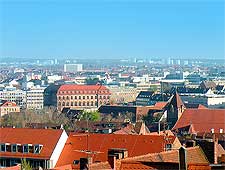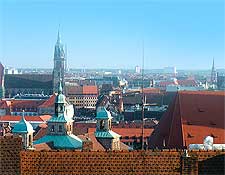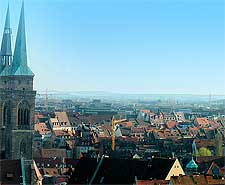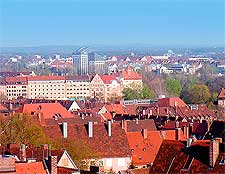Nuremberg History Facts and Timeline
(Nuremberg, Bavaria, Germany)

There have been settlements in this area of Bavaria for literally thousands of years. However, the first historical records to mention Nuremberg - or rather, Nourenberc - date back to the mid-11th century.
In 1219, history records show that Nuremberg was granted the tile of imperial city by Emperor Frederick II. During the Middle Ages, Nuremberg grew to become a great trade centre, benefiting from its strategic location between
Italy and northern Europe. Some of the most important trading routes passed through the city or nearby.
In 1356, a 'Golden Bull' announced that new kings were obliged to hold their first parliamentary session in the city. New buildings sprang up at this time, including the Hauptmarkt, Church of Our Lady and the Old Town Hall.

A Cultural Renaissance
In the 15th and 16th centuries, Nuremberg blossomed into a cultural city. At the centre of the German Renaissance, it was home to artists, sculptors, woodcarvers and printmakers, including Albrecht Durer. The city also attracted humanists, scientists and inventors. The city's first printing press was set up by Anton Koberger in 1470. A year later, an observatory was established by Regiomontanus, an astronomer and mathematician. Around 1500, the first pocket watches were made here and were known locally as 'Nuremberg eggs'. A tradition for 'meistersingers' grew up among the more prosperous artisans of the city.
The city's cultural golden age was followed by a troubled period. In 1532, the Peace of Nuremberg was signed, which acknowledged the city's acceptance of the Reformation. The Lutherans who lived here gained a number of concessions. However, the Reformation jeopardised Nuremberg's role as a royal city. In 1632, the Swedish King Gustavus II was besieged in the city by General Albrecht Wenzel Eusebius von Wallenstein. The city suffered as a consequence of the Thirty Years' War, continuing to decline even after the war had ended.

Arrival of Industry and Socialism
By the 19th century, Nuremberg had transformed itself into an industrial city. The first steam railway in Germany opened in 1835. It ran between the city and nearby Furth.
In the 20th century, Nuremberg rose to preeminence both nationally and internationally, and was connected to some of the most significant events in German history. The city became an important centre for Hitler's National Socialists. Indeed, the party held their annual congresses here between 1933 and 1938. Nuremberg was also the home of Julius Streicher, a Nazi leader and editor of 'Der Sturme'.
In 1935, the Nuremberg Laws were promulgated, which led to many restrictions in the lives of German Jews. During World War Two, the city produced almost half of Germany's planes, submarine and tank engines, and consequently, it was heavily bombed by Allied forces. Indeed, by 1945, over 90 percent of its 'Old Town' district had been totally destroyed.

The Post-War Era of History
After the war, the city was chosen as the venue for the international tribunal for war crimes. The Nuremberg Trials were held between 1945 and 1946 in the city's Palace of Justice, one of the few buildings in the city to remain largely intact.
The post-war period saw a number of positive initiatives to restore the city's historic centre. Many of its more ancient buildings were painstakingly rebuilt. New projects have included an airport and underground railway. Today, Nuremberg is still an industrial city, becoming well-known for its Christmas market.
 There have been settlements in this area of Bavaria for literally thousands of years. However, the first historical records to mention Nuremberg - or rather, Nourenberc - date back to the mid-11th century.
There have been settlements in this area of Bavaria for literally thousands of years. However, the first historical records to mention Nuremberg - or rather, Nourenberc - date back to the mid-11th century.

